I still remember my first time riding Western when I was about 12. I trained in English from a young age, so I was a little surprised by the bulky saddle and relaxed style. A few of my friends rode Western, but none of them had primed me with any Western horseback riding tips.
If you’re just getting into riding, make sure to get my FREE Beginner Rider’s EBook! You’ll learn how to keep a consistent pace (whether you’re riding a fast or slow horse), how to make smoothen transitions, how to finally get the flexion and bend you want, The Emergency Brake as well as bonus chapters on making cantering and jumping so much easier!
On my first day, one of the ranch hands that was riding with us immediately went into a full gallop across the field away from the barn so our horses took off after his.
I managed to stay on throughout the gallop by gripping the horn for dear life. Also I have to give most of the credit to the paint I was riding, who was such a smooth ride.
That ride was when I learned #6 of my Western horseback riding tips: double check you and your horse are a good match.
My friend, Jules, didn’t have quite as happy an ending as I did! She gracelessly fell off her horse. We’ll come back to her in #10 of my Western horseback riding tips!
Looking back now, I honestly don’t know whether to laugh or shudder at the thought of what could have gone wrong.
Since then I’ve picked up a lot of ideas on how to feel, look and act more like a born and bred rider even on your first Western horseback ride.
If you’re reading this, you’re probably about to go on a Western ride sometime soon. Maybe you’ve already gone out for a few rides or maybe this one is your first? Either way, you want to feel, look and act more like a born and bred rider.
Well not to worry – you’ve come to the right gal! Here, I’ll take you through my top 10 Western horseback riding tips for beginners.
Every rider was once a beginner
First of all, remind yourself that everyone has been where you are at one time or another. Even the greatest cowboys and rodeo stars started out exactly where you are now.
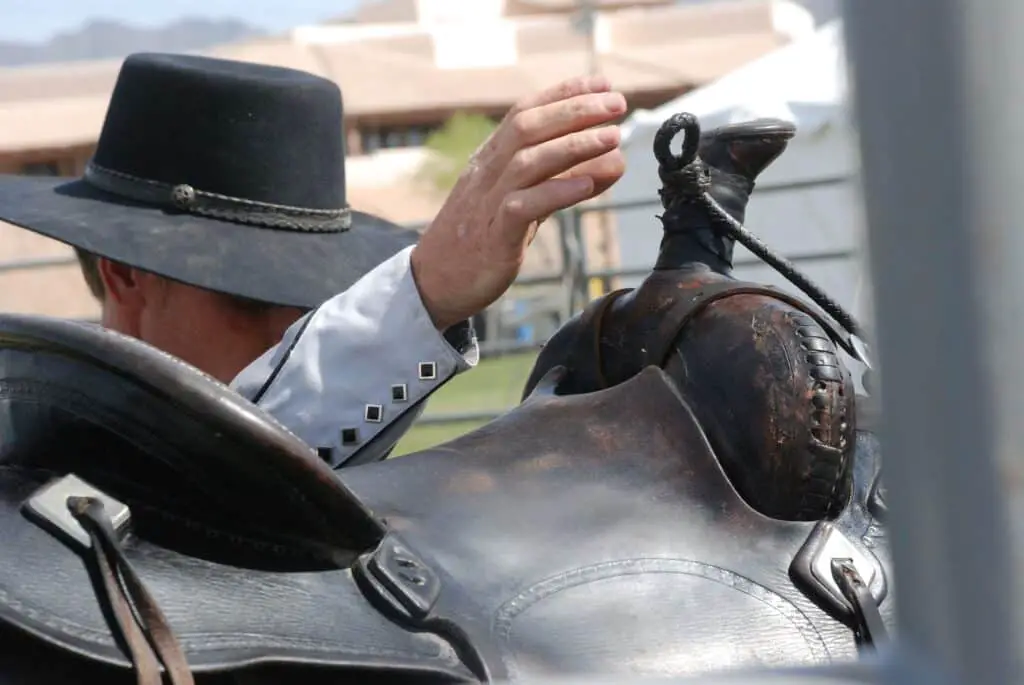
Except, of course, they didn’t have my list of Western horseback riding tips to help them!
Tip 1: Looking like a cowboy or cowgirl will improve your confidence
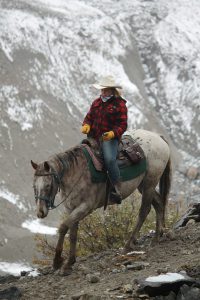
If you look the part, you will feel the part. Please don’t wear a baggy pair of sweat pants or a tight skirt or some sky high heels. You’ll end up looking and feeling awkward and silly (if you’re allowed to get on your horse at all).
Instead, wear a comfortable pair of jeans, a comfortable shirt (with additional layers depending on how cold it is outside) and a pair of cowboy boots.
You want the jeans to be stretchy enough so you can do lunges easily. This mimics the motion of you mounting and dismounting your horse.
Layers are key if it’s cold because you can take layer by layer off. Just tie them around your waist or put them in a saddle bag if you get hot.
And finally, if you don’t have cowboy boots then you have two options. Your first is to go out and buy a pair – I wear mine everywhere, and I think they’re a great investment. Your second is to see if you have a pair of boots with a small heel on them. No 3 inch heels and no flat converse! Something with a heel like your thumb width should be good.
To learn more Western horseback riding tips about your attire, have a look at my guide to rider’s gear and apparel, and scroll to the Western section.
Tip 2: Get comfortable with Western lingo
You’ll want to understand what the others are talking about when they mention different horse gaits, different tack components and different horse colours. This way you can join in, comment and it will help you learn more and just get more involved.
My first day in a Western saddle, I learned pretty quickly the difference between a canter and a gallop! Riding English in the arena, you don’t really know what a gallop feels like.
It’s a completely different feeling to be full speed ahead across a flat field with nothing to slow you down!
Horses generally have 4 different gaits:
- Walk: slowest, four-beat gait so each of the hooves hits the ground one at a time
- Trot: slightly faster, two-beat gait that’s usually the most bumpy
- Canter/Lope: faster, three-beat gait that has a left and right lead (think show jumping!)
- Gallop: fastest gait with four beats (think race horses!)
The Basics of Western Tack:
- The bridle: halter-type appliance around the horse’s head that keeps the bit in place
- The bit: metal (or sometimes rubber) piece that sits in the horse’s mouth
- The reins: leather straps attached to the bridle at the edges of the bit that you hold
- The saddle: leather “seat” and accessories that sits on the horse’s back
- The stirrups: where you put your feet when you ride
- The horn: the leather protrusion at the front of the saddle
- The saddle pad(s): the pads that sit below the saddle on the horse and prevent sores
To learn more about Western tack, check out this page on equestrian equipment and scroll to the Western section.
The Basics of Horse Colouring:
- Grey: pretty self explanatory
- Bay: brown body with darker brown mane and tail
- Chestnut: very light brown or auburn body, mane and tail
- Palomino: beige body with blond mane and tail
- Pinto: splashy! think of a cow and you’ve got black and white pinto colouring
- Appaloosa: spotty! either on the bum or across the whole body
- Roan: two-toned coat spread evenly throughout the entire body
Here is a good and complete colour chart if you want to learn more:
There are also many different horse markings. I haven’t included them here because even I don’t remember all of them by heart! Just shoot me a comment below if you’re curious and I’ll write a post about it 🙂
Tip 3: Try your best to keep nerves to a minimum
This one is tough I know but it’s also so important. Horses are extremely sensitive to your emotions.
They sense when you’re scared and nervous or relaxed and happy. And since horses don’t generally perceive themselves as scary (they are herbivores and thus animals of prey – other animals hunt them in the wild), they won’t think that they’re the reason you’re nervous.
Instead your horse will think that there is something scary nearby and therefore they will start to get scared as well.
Since horses are predominantly flight animals, they have an urge to run when they’re nervous.
So by being nervous, you are giving your horse a reason to become jumpy, flighty and generally less compliant.
Some quick ways to decrease nerves before and during a ride:
- Deep breathing exercises with your diaphragm (not your chest!)
- Pet your horse, talk to him and become friends
- Be social and talk to others on the ride
- Ask lots of questions – the faster you learn the sooner you’ll become a natural
- Laugh as often as possible
- Don’t take yourself too seriously – it doesn’t matter if you mess up!
- Remind yourself that ‘real’ riders fall off all the time
- Take note of the safety reminders the trail boss (or whoever is in charge) gives you – as long as you stick to these you’re good!
Tip 4: Assuming the “pro” riding position
Sitting in the saddle will soon become comfortable and second nature to you once you’ve been riding for a little bit. But until then, you can simply “fake it ’till you make it.”
Western riding is very relaxed, so you want to imagine your body sinking deep into the saddle.
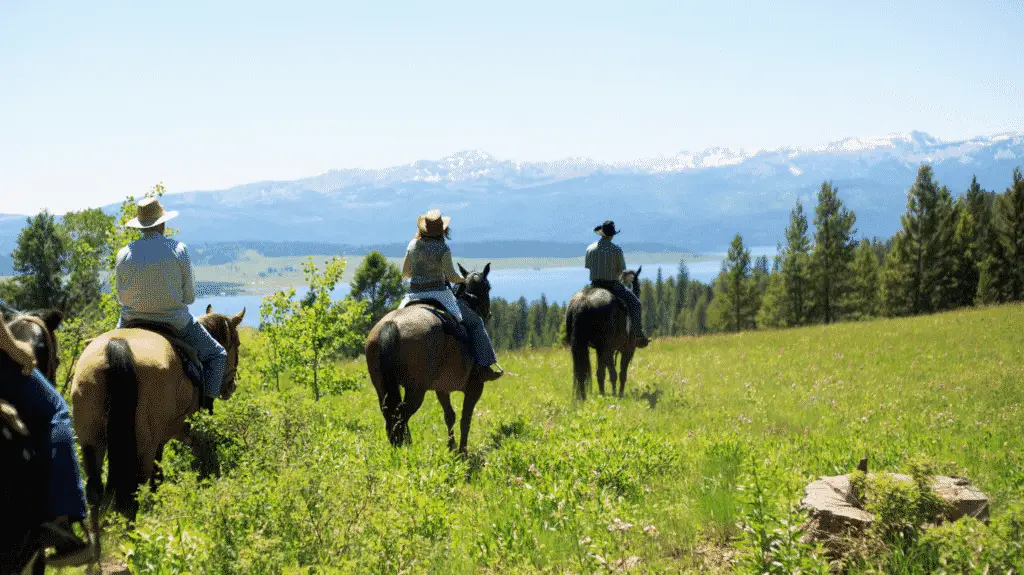
The weight of your legs should drop heavily into your feet and through to the stirrups.
You want to feel your horse’s movements with your hips and let your body fall into the natural rhythm of your horse. This doesn’t mean try and move your horse with your hips as your horse won’t like all the weird shifting weight on their back. Instead, just let yourself flow as naturally along as possible.
Saying this, relaxed doesn’t mean half-asleep. Make sure you keep alert and don’t let yourself slouch over. Just try and imagine that you’re one with your horse. Imagine being your horse – ask yourself, what kind of rider would you want to have on your back?
Remember when you were a kid and you gave your little brother a piggy back ride?
Did you want him moving all over the place or hanging off to one side? Your horse doesn’t either!
So don’t lean consistently to one side, too far forward or too far back. Try and keep yourself centred.
This isn’t really an issue when you’re just walking in a straight line but as you start going up and down hills, doing tight turns at a trot or a canter, or generally winding through bushes and trees it can sometimes feel natural to lean one way or the other – try to avoid this urge.
You can also stand up in the saddle using your stirrups every once in a while on longer rides to provide your horse some relief from your weight constantly being in the same place.
Tip 5: One hand only ladies and gents!
If you’ve ever ridden English then you need to forget everything about how to hold your reins because in Western, things are completely different. Your thumbs don’t need to be up, you don’t need to have a rein in each hand, you can have more slack and your arms don’t have to be up. Also, your horse’s head can be lower and more relaxed than in English.
Instead, learn how to master doing everything with one hand and with some slack in the reins – aka “neck reining”.
Hold the two reins in one hand, and simply move your hand slightly forward and left if you want to go left or slightly forward and right if you want to go right.
Also, use your legs more and even your hips a little bit when turning to help your horse along. You can twist your hips slightly in the direction that you want to go, and your horse will pick up on this signal if they are well trained. Furthermore, you want to squeeze your horse with the leg opposite of the direction you want to turn in as your horse should naturally move away from the pressure.
Tip 6: Double check you and your horse are a good match
Whoever is running the ride, or the horse’s owner(s) should know what they’re doing when assigning a horse to you.
So if this is your first ride, they should give you a thicker, slower and generally calm horse.
Remember my story at the beginning? You don’t want to be taken off at a gallop within the first few minutes of getting on. Even if you’ve ridden before, it’s better to be safe than sorry when you’re at a new facility with new horses.
If you notice that the horse you got is restless, jumpy or just seems greener than you’re comfortable with, then don’t be afraid to speak up!
It will be much more embarrassing – and potentially dangerous – when you can’t control the horse during your ride than if you speak up now.
Tip 7: Don’t forget to be affectionate!
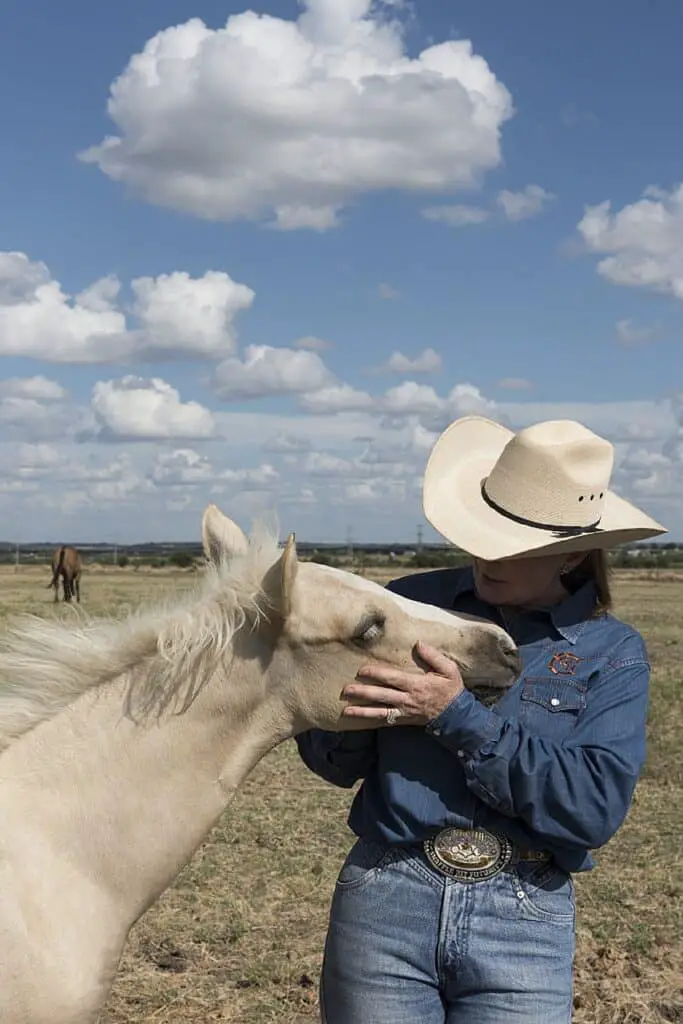
Horses love affection and they can tell whether you’re focused on them or not. So don’t forget to treat your horse like a princess, pat her often and tell her how much of a good girl she is. I really think this is one of the most underrated Western horseback riding tips!
Yes! That means you have to talk to your horse so don’t be shy or embarrassed. All horse owners and lovers talk to their horses all the time.
Before you get started, make sure you learn your horse’s name and use it often throughout the ride as that will help the two of you to bond. Also, you can even bring some treats like whole carrots, apples and sugar cubes. But make sure you ask the owner or trail boss whether your horse is allowed them. Just like us, some horses aren’t as tolerant of treats, or are kept on special diets.
Tip 8: Ask questions and be social
As I mentioned when I was talking about decreasing nerves, it’s great to interact with other riders and the owners of the ranch or establishment that you’re riding at. Learning as much as you can about how the ranch functions, how the horses are taken care of and who takes care of them will help you learn more about horses. It will also give you an idea if you want to keep riding there.
I’ve included some ideas of what to ask but feel free to take these questions further, or ask more of your own that pertain more to your situation! Remember that Western horseback riding tips aren’t just limited to the riding, but the whole experience.
 Some good questions to ask or talk about:
Some good questions to ask or talk about:
- How many horses do you have here?
- How old is my horse?
- Do many riders come through here?
- What feed do you give your horses?
- When do you stall the horses and turn them out?
- How much land do you have?
- Do you have any other animals here?
- What other horse-related stuff do you do here? (Besides trail rides or lessons or whatever you’re participating in at the time)
- Can other people’s horses board here?
- Do you train horses here?
- Do your horses compete in any kind of competitions?
Tip 9: Learn about Western events & competitions
Going off the last question in the list above, it can be interesting and give you something to talk about if you know about different Western competitions and rodeo events. You can do a quick lookup of these types of events near you or the ranch you’re riding at.
If you have any interest in training or competing in these down the line, then that’s all the more reason for you to look them up!
Again, if you’re curious to learn more about these types of events and competitions – shoot me a comment below and I’ll write a post on them! I have plenty of Western horseback riding tips for more seasoned riders to share too!
Tip 10: It’s okay to fall
I know I’m repeating myself a little bit but I think this is important enough to deserve its own tip section. Falling can be a big stigma among new riders for a few reasons.
One reason is that people think falling makes them look inexperienced and silly. Another reason is that people are just plain scared of falling.
Remember the story of my first Western ride I was telling you about earlier with Jules and I?
Well, I managed to stay on throughout the gallop by gripping the horn for dear life. Also I have to give most of the credit to the paint I was riding, who was such a smooth ride.
Jules wasn’t quite as lucky.
Her girth hadn’t been done up tightly enough (the strap that keeps the saddle on) and her saddle shot forwards. Her horse skidded to a halt immediately, worried about his rider, as she shot forward and ended up on his neck. She dismounted/fell off gracelessly but no harm was done to either of them.
We ended up laughing about that for months afterwards.
So no matter what happens during your ride, learn to laugh about it and most of all just enjoy yourself! After all, this is supposed to be fun!
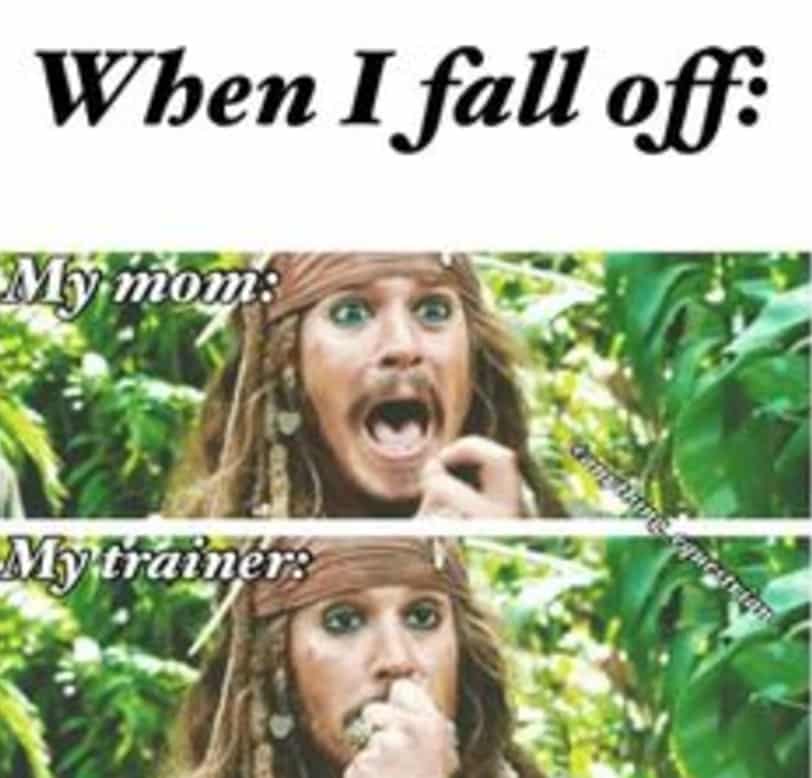
Both of these are completely valid to feel as a new rider. However, falling does not make you look inexperienced or silly in the least. Professional riders still fall plenty of times. There’s even a saying that if you haven’t fallen off at least 20 times (I’ve heard different numbers here) then you aren’t a ‘real rider.’
So the moral of the story is don’t be afraid of falling because you think it will make you look silly!
The trick here is to brush the dirt off, smile and get ready to get right back on.
Usually if you fall, you will be just fine. Just remember to roll as this minimizes impact on your joints and will carry you further from your horse’s hooves.
Of course, if you feel pain – then don’t be afraid to say so! Again, this is nothing to be ashamed of. I once fell on my hip and had a bruise the size of a basketball on it for weeks. I continued because I wanted to finish my jumping routine. BUT I also went to go get checked out at the doctor’s right after to make sure everything was a-okay.
Furthermore, I know it’s scary to think about falling off a horse. It’s high up there and a nervous mind is one that can come up with all sorts of imaginative scenarios about what could go wrong. Refer to the tactics I listed before for managing nerves and I promise once you’re on for 10 minutes you’ll already start getting more confident.
The only real remedy for this unfortunately is to fall off. Once you fall off once, you realize that it’s not that bad.
Another potential solution if you feel like your fear is really interfering with your riding is to try vaulting.
Vaulting is an equestrian discipline in which you’re actually taught how to fall off properly and to dismount and mount your horse while they’re moving. It’s also the sport with the highest safety record out of all horse-related disciplines and so literally the safest way to increase your confidence.
Most Importantly – Have Fun!
Your horse will sense if you’re having fun and as a result, they will be more inclined to relax, have fun and communicate with you. Also presumably the whole reason you’ve decided to try Western riding is to learn something new and fun!
Enjoying yourself is more important than any one of these Western horseback riding tips.
I would love to hear some of your stories about your first rides, or any Western horseback riding tips you might have! Or generally if you have some a funny or inspiring story you’d like to share with everyone, please don’t hesitate at all comment below or e-mail me at [email protected] 🙂
Happy riding!
Martina
Did you like these Western horseback riding tips? Well why not pin this post!



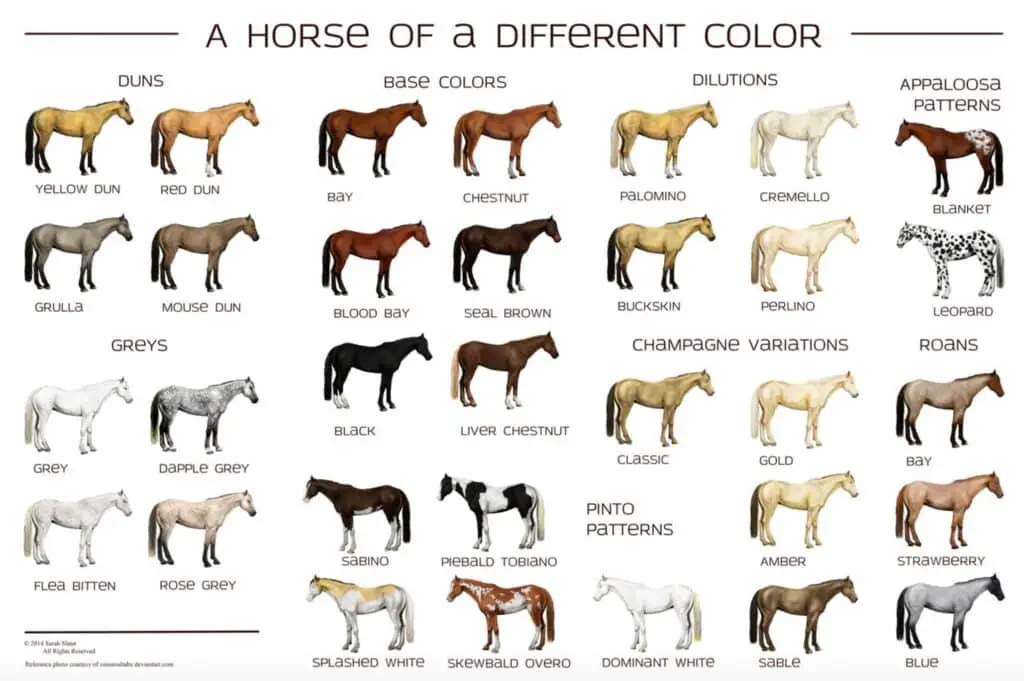
Great topic!
It’s been a looong time since I’ve been on a horse and even longer since being in a western saddle. I’ve mostly ridden English and usually only ride western for trail riding.
I like how you emphasized deep breathing, relaxation, and having fun. Everyone should remember those things, even experienced riders!
Hey Jo!
I completely agree with you that even experienced riders can sometimes tense up – especially if they’ve had some accidents in the past or are competing and simply letting the stress of the competition and winning get the better of them. For all levels, it can become really easy to forget to just relax and have a good time when you’re on a horse! As I mentioned, this is really what it’s all about in the end 🙂 And the more fun you have, the more fun your horse will have!
And I’ve talked to so many riders who’ve been out of the saddle for a while – myself included a while ago! I took several years off of riding and sometimes you can get up in your own head when you go back to it.
Hope you decide to start riding again at some point Jo!
Cheers,
Martina
This article popped up at a perfect time! My husband is a big time country boy and he has been looking into getting back into bull riding. I kindu don’t want to be left out, so I’ve been looking at lessons and eventually competing in something myself. Love these beginner tips! Currently the only female friendly competition to someone just getting started that I’m aware of is to train for barrel racing. Are there other’s you could suggest to start off with training for eventually? Thanks!
Hey there! Ahhh I’m so excited for you – getting started with riding is such an exciting time and I know you’re going to love it. I also wish your husband the best of luck getting back into the swing of things in the rodeo and bull riding!
Yes you’re right, with a lot of Western style and rodeo events, it’s still more of a “man’s world”. However, there’s still some events that you can compete in! I would even go as far to say that you could do any of them if you really want to but some events definitely will take a lot more effort to work your way into then others and you could get some interesting looks…haha
For more of the women-friendly events, I would look into like you mentioned barrel racing, reining and roping.
Reining is kind of like Western dressage where you’re focused more on control and discipline rather than speed or high risk activities (like bronc riding). Roping is being able to rope like a calf for example from horseback and it’s usually a timed event. There’s also team roping that’s pretty fun where you rope one end and your partner ropes the other end of the calf. It takes quite a bit of skill but it’s definitely fun!
Here’s a link to the Women’s Pro Rodeo Association – I think you might find it helpful to look more into: http://wpra.com/index.php
Here’s another link to a freestyle reining performance (with music! haha) : https://www.youtube.com/watch?v=JgzuyvFOLik
Hope this helps! Don’t hesitate to comment back or e-mail me if you have more questions ([email protected])
Cheers
Martina
I have been involved with horses since childhood as a trainer, coach, judge & breeder. Just want to say that your explanation for the beginner rider is excellent! Should certainly help a new rider become more comfortable and even some good tips for us oldies. And stressing the fun part is a bonus, many forget to just enjoy their surroundings. I have an equine related website too but mine is relating to healthy natural alternatives if you care to have a peek?
Hey there Allie!
Thanks so much for your positive feedback 🙂 Feel free to add anything that you think is missing as well. It’s interesting to hear that you have experience breeding! I’ve never really bred horses before so it would be awesome to learn something about that – I’ll definitely check out your site on healthy natural alternatives. I’ve actually just been introduced to this new all natural shampoo and conditioner that smells amazing by Sun Horse! I’m going to give it a try and I’ll probably write a review on it that I hope you check out as well
how do you train your horse to change leads
Hey Morgan,
Thanks for your question 🙂
If you mean from a trot, let’s say I’m going clockwise – I like to trot down the long side of the arena and then at the corner, I’ll pull my left heel back behind the girth, keep my right heel forward and give a kick with my left leg. At the same time, I’ll push my hands forwards making sure there’s no pressure on the reins giving mixed signals. By asking in the corner, the horse should instinctively start the canter on the right lead because they’re turning right. By doing this enough times, you’re also associating your leg cues (left leg back) with the right lead.
Once you’ve mastered this, then you can begin asking for the correct lead from a trot during a diagonal change. And eventually you’ll be able to do a lead change half way through a diagonal at a canter by switching the position of your legs and kicking with the appropriate heel back.
Hope this helps!
Warmly,
Martina
I would like to thank you for your website! I grew up loving horses, but I had a pretty bad accident when tearing through the woods one day. I never climbed back on a horse, and it’s been that way for 40 years. I can’t believe it, but reading through your article makes me want to get back up there. Thank you for your inspiration!
Clay
Hey Clay,
Awww thank you for your kind words – that sounds really scary. I’m so happy you found our website inspiring 🙂
Cheers,
Martina
Hi!
I really liked your article althoug I have never been riding a horse my self. The only experience I have was with a girlfriend I had when I was a teenager. She and her family had a lot of horses that they trained and I remember that I was scared to death all the times when we were at here home 😉
Anyway, I found your article to be very interesting because I’ve been thinking recently I should try it myself before I’m getting to old.
Patrik
Hey Patrik!
No such think as too old to horseback ride – and I defintely think you should give it a shot. You can book a trail ride at your closest ranch and just take it at a walk 🙂
Cheers,
Martina
I agree I just got off a horse and I thought that all those things really help d me as a rider
So happy to heart that Charlie!
Hi Martina,
This is a great article! These tips are very practical and they can be followed easily.
I’d love to try them out as soon as possible, thanks so much for sharing. I’m going on a vacation with trail rides so should be useful.
Hopefully with some of these, I’ll look like a pro soon enough haha although I know I definitely want to avoid falling off
Hi Shavo, Typically vacation-type trail rides are very relaxed. Don’t worry about falling off, just enjoy! I’m so glad that you found it helpful
Like I said in one of your previous posts, I am looking for a good way for me to learn about the western riding and now you have some tips for me. This tips really makes it seem to me like it is easy and I know it isn’t bit it’s nice and I would remember all this whenever I want to try it again.
It’s easier than you think John to get on and start riding! A lot of the struggle is mental, especially as an adult. If you have an older, calmer horse, you’d be surprised how well you’d do on a trail! Best of luck
Wow . Interesting list of tips . I laughed at the last one ‘ Its okay to fall’. This is my greatest fear but deep down i know it is inevitable especially for beginners to find themselves covered by dust. Horse riding has been in my bucket list for long but always find excuses because I am really scared. Your tips were really helpful as I revisit my bucket.
Awww so happy to hear that! You should definitely go for it! Trail riding on an older, calm horse just at a walk is a great place to start and it’s quite unlikely that you would fall.
Absolutely stunning page!! I love the flow and coordination, so easy on the eyes <3. I also really really like the professionalism of the page. It comes off more as a magazine or an advice column, which I like. The organization comes off as easy to understand. I also appreciate how your referrals seem more like resources than affiliates. I can tell you really put a lot of love and care into the site. I bet the conversions are so organic. 10/10- Bravo!!
Thanks for the feedback 🙂
I used to ride horses when I was 12 and it was a good experience. I bought the riding gear and you’re right, it helps boost your confidence. I had good boots and I always wore comfortable jeans. I went to a riding stable and I was given a large male horse called Marco. At first he intimidated me because he was huge! But after the first time I rode him, I loved him and I requested him every time since then. I loved those rides outside in the woods and fields. Marco and I were one. Until one day when I arrived at the stable and Marco wasn’t there anymore …
After Marco died, I never rode again. I tried with a few other horses, but it wasn’t the same. None of them were Marco. I have not ridden again since then. Marco and I really bonded.
Awww Christine I’m sorry to hear that. I remember bonding with my first pony too and there’s always something that will be very special and unique about that bond. I totally understand the difficulty to connect with another horse afterwards.
Hi there!
This article is very appreciated on my behalf because I just started taking western riding lessons yesterday. We (unfortunately) got mares as our lesson horses (when I say we, I mean me and some other girl), and boy did they have some sass! I’m actually a younger teenager commenting this, and dream to ride English (but am learning Western to be well-rounded or whatev) and pursue my dreams of owning a horse one day.
Sincerely,
Emma
Hi Emma,
I’m so happy you enjoyed the article. Oh no… yeah, mares can be awfully moody sometimes. Exactly why I chose to buy a gelding! That’s awesome! I’m sure you will absolutely achieve that dream 🙂 Don’t let anything stand in your way & best of luck!
Martina
Thank you so much for the article! I have always wanted to ride but my sister kept putting me down saying I could never do it and now I am ready to prove her wrong!
Hey Olivia!
That’s amazing!!! I am absolutely loving your attitude. Lots of people told me that I couldn’t handle a young horse but I proved them wrong when I bought my 4-year-old Rudy. There were tough times but I stuck through it and he’s an angel now. I’d love to hear how the riding journey goes for you 🙂
Enjoy educating myself more and more and this was a great article to read and pinned it to my Pinterest Board. Since I am now recovering from a recent fall, I thought that your words were right on. I have fallen too many times and the last one was more significant. BUT, I will tell you that the fall was no fault of my horse, but myself going faster than I should of. I just turned 60 and I will tell you that the fear of falling again will not stop me from riding and becoming a better rider in years to come.
Thanks
I loved that you said that the saddle pads could prevent sores, and they are the pads that sit below the saddle on the horse. This reminded me of my father who is planning to shop for western saddles for his horses. He said that he is interested in horse riding, and he wants him and his horses to be comfortable during his trips. I will ask him to consider shopping for the right western saddles.